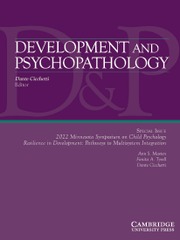Crossref Citations
This article has been cited by the following publications. This list is generated based on data provided by
Crossref.
Alink, Lenneke R. A.
Cyr, Chantal
and
Madigan, Sheri
2019.
The effect of maltreatment experiences on maltreating and dysfunctional parenting: A search for mechanisms.
Development and Psychopathology,
Vol. 31,
Issue. 1,
p.
1.
Handley, Elizabeth D.
Russotti, Justin
Rogosch, Fred A.
and
Cicchetti, Dante
2019.
Developmental cascades from child maltreatment to negative friend and romantic interactions in emerging adulthood.
Development and Psychopathology,
Vol. 31,
Issue. 5,
p.
1649.
Toth, Sheree L.
Handley, Elizabeth D.
Manly, Jody Todd
Sturm, Robin
Adams, Tangeria R.
Demeusy, Elizabeth M.
and
Cicchetti, Dante
2020.
The Moderating Role of Child Maltreatment in Treatment Efficacy for Adolescent Depression.
Journal of Abnormal Child Psychology,
Vol. 48,
Issue. 10,
p.
1351.
Negriff, Sonya
Palmer Molina, Abigail
and
Hackman, Daniel A.
2020.
Parental Exposure to Childhood Maltreatment and Offspring’s Mental Health: Investigating Pathways Through Parental Adversity and Offspring Exposure to Maltreatment.
Child Maltreatment,
Vol. 25,
Issue. 4,
p.
422.
Moser, Dominik Andreas
Suardi, Francesca
and
Schechter, Daniel Scott
2020.
Childhood Trauma in Mental Disorders.
p.
211.
Langevin, Rachel
Marshall, Carley
and
Kingsland, Emily
2021.
Intergenerational Cycles of Maltreatment: A Scoping Review of Psychosocial Risk and Protective Factors.
Trauma, Violence, & Abuse,
Vol. 22,
Issue. 4,
p.
672.
Adams, Tangeria R.
Handley, Elizabeth D.
Warmingham, Jennifer M.
Manly, Jody Todd
Cicchetti, Dante
and
Toth, Sheree L.
2021.
Patterns of Dating Violence Moderate the Effect of Child Maltreatment on Suicide Risk among Disadvantaged Minority Female Adolescents with Depressive Symptoms.
Journal of Family Violence,
Vol. 36,
Issue. 1,
p.
5.
Cerdeña, Jessica P.
Rivera, Luisa M.
and
Spak, Judy M.
2021.
Intergenerational trauma in Latinxs: A scoping review.
Social Science & Medicine,
Vol. 270,
Issue. ,
p.
113662.
Nobes, Gavin
Panagiotaki, Georgia
Malvaso, Catia
and
Klevens, Joanne
2022.
Physical Abuse of Children by Stepfathers in Colombia.
Journal of Interpersonal Violence,
Vol. 37,
Issue. 7-8,
p.
NP5747.
Berzenski, Sara R.
and
Yates, Tuppett M.
2022.
Handbook of Child Maltreatment.
Vol. 14,
Issue. ,
p.
351.
Thomas, Jordan L.
Keenan-Miller, Danielle
Sumner, Jennifer A.
and
Hammen, Constance
2022.
Early Life Adversity and Clinical Intimate Partner Violence in Adulthood: The Mediating Role of Interpersonal Conflict in Adolescence.
Journal of Interpersonal Violence,
Vol. 37,
Issue. 21-22,
p.
NP21345.
Bender, Anna E.
McKinney, Sherise J.
Schmidt-Sane, Megan M.
Cage, Jamie
Holmes, Megan R.
Berg, Kristen A.
Salley, Jessica
Bodell, Marissa
Miller, Emily K.
and
Voith, Laura A.
2022.
Childhood Exposure to Intimate Partner Violence and Effects on Social-Emotional Competence: A Systematic Review.
Journal of Family Violence,
Vol. 37,
Issue. 8,
p.
1263.
Bérubé, Annie
Turgeon, Jessica
Clément, Marie-Ève
Lafantaisie, Vicky
and
Milot, Tristan
2022.
Les expériences de maltraitance vécues par les mères durant leur enfance et le lien entre l’environnement dans lequel l’enfant grandit et la réponse à ses besoins.
Revue de psychoéducation,
Vol. 51,
Issue. 3,
p.
55.
Hitzler, Melissa
Bach, Alexandra M.
Köhler-Dauner, Franziska
Gündel, Harald
and
Kolassa, Iris-Tatjana
2022.
Long-Term Consequences of Childhood Maltreatment Among Postpartum Women—Prevalence of Psychosocial Risk Factors for Child Welfare: An Independent Replication Study.
Frontiers in Psychiatry,
Vol. 13,
Issue. ,
Bogat, G. Anne
Levendosky, Alytia A.
and
Cochran, Kara
2023.
Developmental Consequences of Intimate Partner Violence on Children.
Annual Review of Clinical Psychology,
Vol. 19,
Issue. 1,
p.
303.
Lotto, Camila Regina
Altafim, Elisa Rachel Pisani
and
Linhares, Maria Beatriz Martins
2023.
Maternal History of Childhood Adversities and Later Negative Parenting: A Systematic Review.
Trauma, Violence, & Abuse,
Vol. 24,
Issue. 2,
p.
662.
Brühl, Antonia
Ward, Catherine L.
Lachman, Jamie M.
Foran, Heather M.
Raleva, Marija
Baban, Adriana
and
Heinrichs, Nina
2023.
Co-Occurrence of Intimate Partner Violence Against Mothers and Maltreatment of Their Children With Behavioral Problems in Eastern Europe.
Violence Against Women,
Vol. 29,
Issue. 12-13,
p.
2439.
Yu, Xinyi
He, Ting
Tan, Yuxin
Chi, Peilian
and
Lin, Xiuyun
2023.
Intergenerational effects of childhood maltreatment: The relationships among parental childhood emotional neglect, emotional expressiveness and children's problem behaviors.
Child Abuse & Neglect,
Vol. 140,
Issue. ,
p.
106147.
Bravo, Patricia
Kim, Yugyun
Xerxa, Yllza
Koopman-Verhoeff, M. Elisabeth
Cárcamo, Rodrigo
Oldehinkel, Albertine
Hillegers, Manon
and
Jansen, Pauline
2023.
Maternal history of maltreatment and offspring's emotional and behavioral problems in adolescence: Do family factors contribute to the intergenerational risk transmission?.
Child Abuse & Neglect,
Vol. 141,
Issue. ,
p.
106228.
Negriff, Sonya
Fritz, Hannah L.
and
Ji, Juye
2023.
Parental Depression and Adulthood Adversities as Mediators of Direct Versus Indirect Intergenerational Experiences of Child Maltreatment.
Journal of Family Violence,




